Analysis of Corporate Governance Failures and Liquidation in Australia
VerifiedAdded on 2020/11/23
|9
|2534
|448
Report
AI Summary
This report provides an in-depth analysis of corporate governance failures and their role in the liquidation of Australian companies. It begins with an executive summary and an introduction to the concept of liquidation, differentiating between voluntary and compulsory processes. The main bo...

ACCOUNTING
FINANCIAL
1
FINANCIAL
1
Paraphrase This Document
Need a fresh take? Get an instant paraphrase of this document with our AI Paraphraser
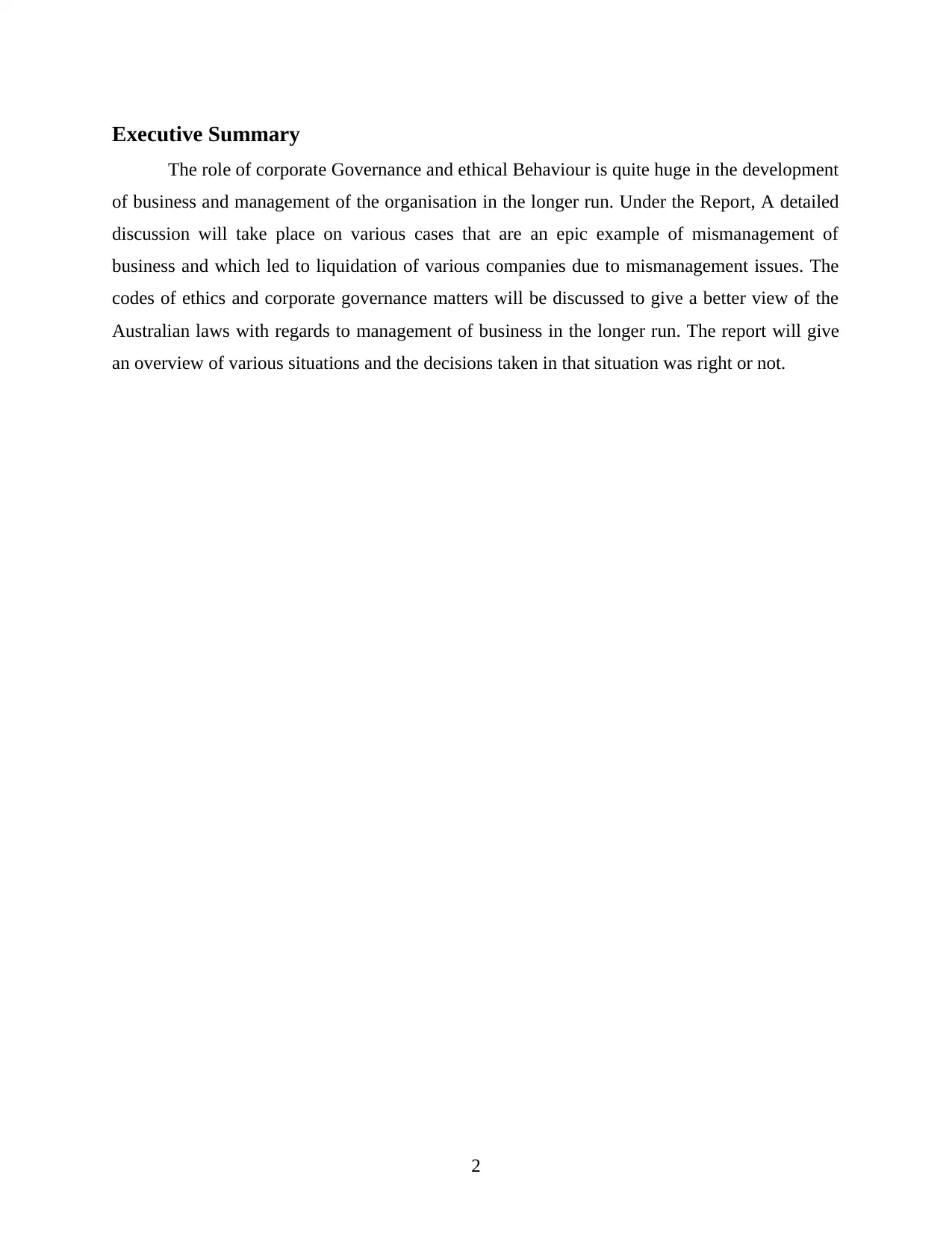
Executive Summary
The role of corporate Governance and ethical Behaviour is quite huge in the development
of business and management of the organisation in the longer run. Under the Report, A detailed
discussion will take place on various cases that are an epic example of mismanagement of
business and which led to liquidation of various companies due to mismanagement issues. The
codes of ethics and corporate governance matters will be discussed to give a better view of the
Australian laws with regards to management of business in the longer run. The report will give
an overview of various situations and the decisions taken in that situation was right or not.
2
The role of corporate Governance and ethical Behaviour is quite huge in the development
of business and management of the organisation in the longer run. Under the Report, A detailed
discussion will take place on various cases that are an epic example of mismanagement of
business and which led to liquidation of various companies due to mismanagement issues. The
codes of ethics and corporate governance matters will be discussed to give a better view of the
Australian laws with regards to management of business in the longer run. The report will give
an overview of various situations and the decisions taken in that situation was right or not.
2
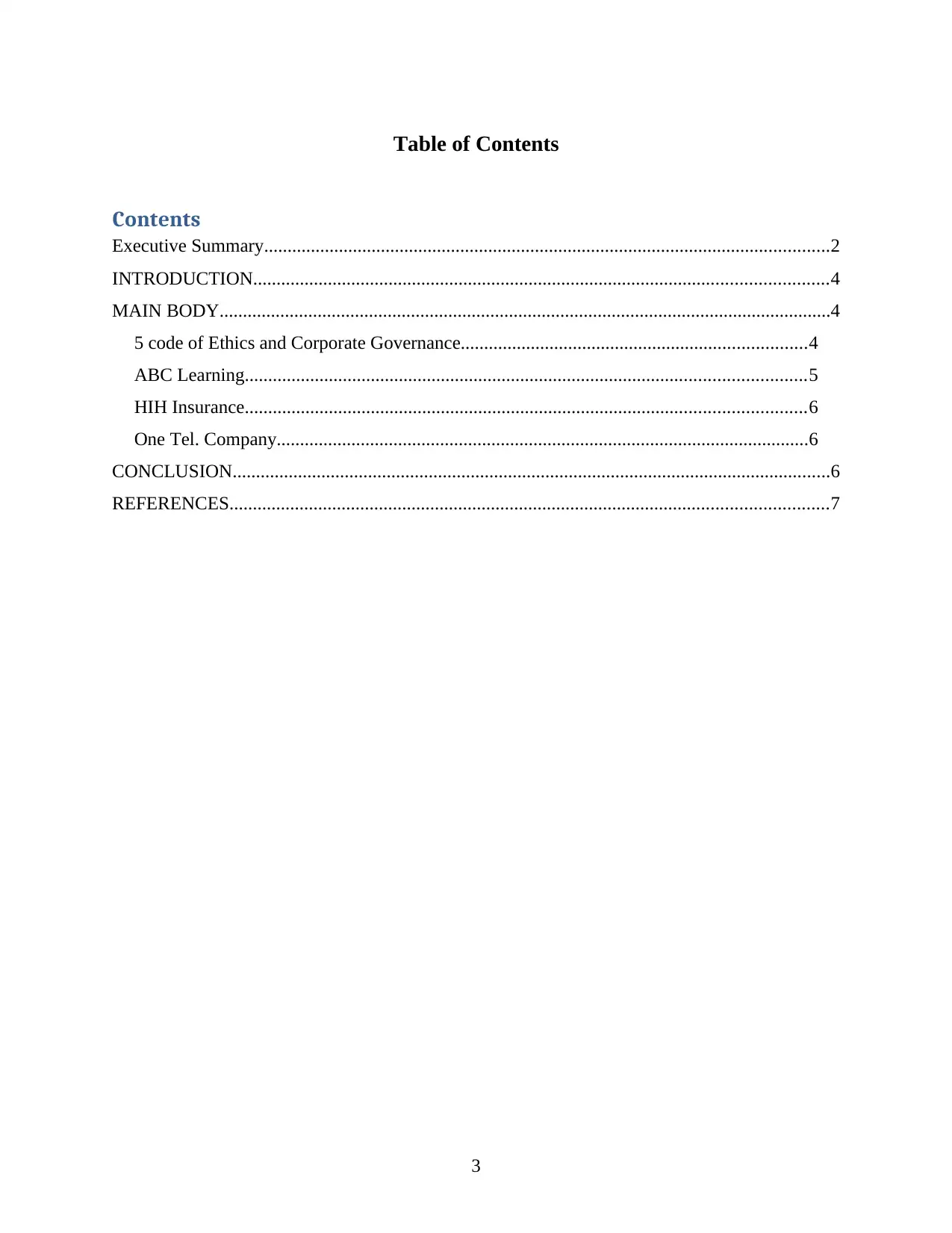
Table of Contents
Contents
Executive Summary.........................................................................................................................2
INTRODUCTION...........................................................................................................................4
MAIN BODY...................................................................................................................................4
5 code of Ethics and Corporate Governance..........................................................................4
ABC Learning........................................................................................................................5
HIH Insurance........................................................................................................................6
One Tel. Company..................................................................................................................6
CONCLUSION................................................................................................................................6
REFERENCES................................................................................................................................7
3
Contents
Executive Summary.........................................................................................................................2
INTRODUCTION...........................................................................................................................4
MAIN BODY...................................................................................................................................4
5 code of Ethics and Corporate Governance..........................................................................4
ABC Learning........................................................................................................................5
HIH Insurance........................................................................................................................6
One Tel. Company..................................................................................................................6
CONCLUSION................................................................................................................................6
REFERENCES................................................................................................................................7
3
You're viewing a preview
Unlock full access by subscribing today!
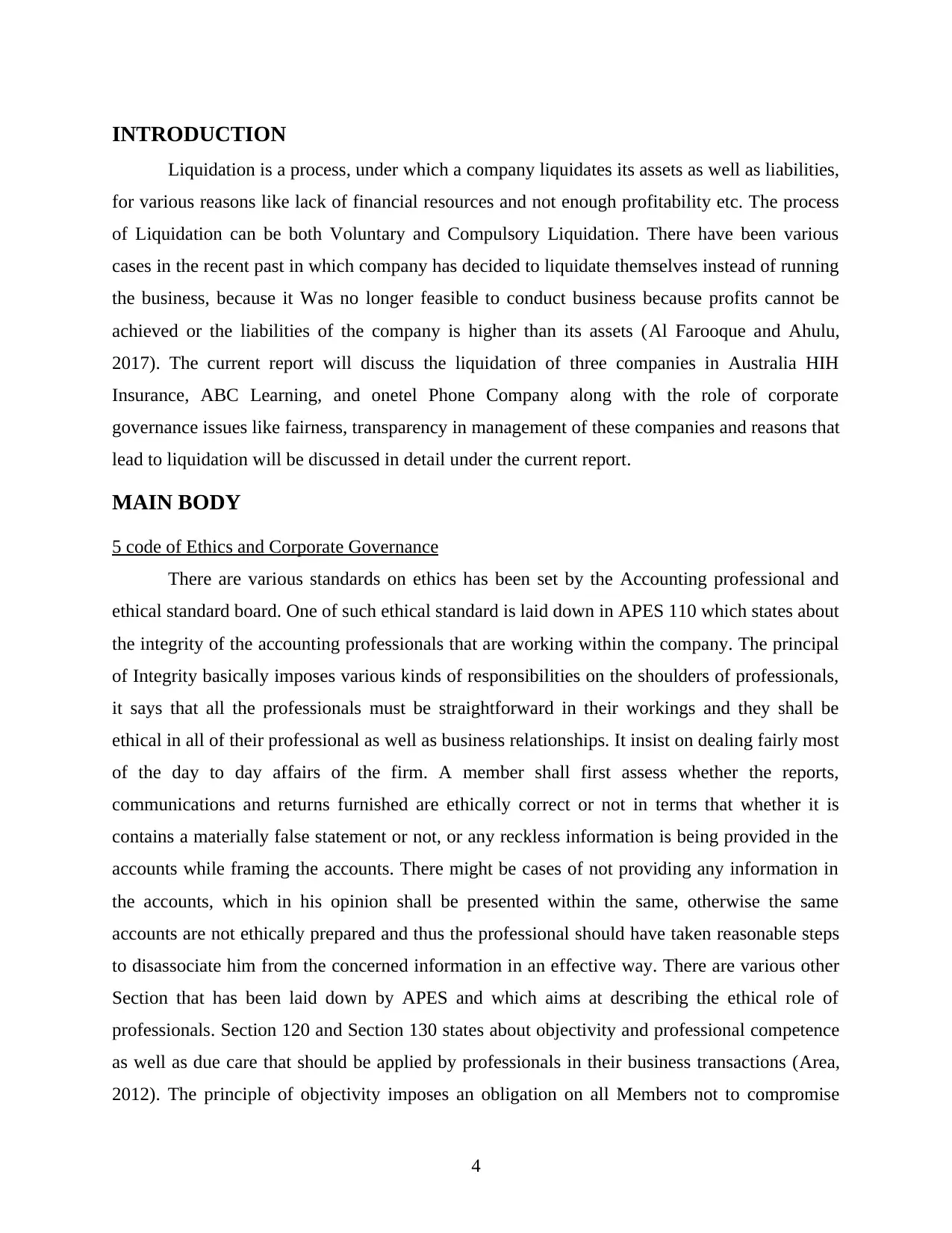
INTRODUCTION
Liquidation is a process, under which a company liquidates its assets as well as liabilities,
for various reasons like lack of financial resources and not enough profitability etc. The process
of Liquidation can be both Voluntary and Compulsory Liquidation. There have been various
cases in the recent past in which company has decided to liquidate themselves instead of running
the business, because it Was no longer feasible to conduct business because profits cannot be
achieved or the liabilities of the company is higher than its assets (Al Farooque and Ahulu,
2017). The current report will discuss the liquidation of three companies in Australia HIH
Insurance, ABC Learning, and onetel Phone Company along with the role of corporate
governance issues like fairness, transparency in management of these companies and reasons that
lead to liquidation will be discussed in detail under the current report.
MAIN BODY
5 code of Ethics and Corporate Governance
There are various standards on ethics has been set by the Accounting professional and
ethical standard board. One of such ethical standard is laid down in APES 110 which states about
the integrity of the accounting professionals that are working within the company. The principal
of Integrity basically imposes various kinds of responsibilities on the shoulders of professionals,
it says that all the professionals must be straightforward in their workings and they shall be
ethical in all of their professional as well as business relationships. It insist on dealing fairly most
of the day to day affairs of the firm. A member shall first assess whether the reports,
communications and returns furnished are ethically correct or not in terms that whether it is
contains a materially false statement or not, or any reckless information is being provided in the
accounts while framing the accounts. There might be cases of not providing any information in
the accounts, which in his opinion shall be presented within the same, otherwise the same
accounts are not ethically prepared and thus the professional should have taken reasonable steps
to disassociate him from the concerned information in an effective way. There are various other
Section that has been laid down by APES and which aims at describing the ethical role of
professionals. Section 120 and Section 130 states about objectivity and professional competence
as well as due care that should be applied by professionals in their business transactions (Area,
2012). The principle of objectivity imposes an obligation on all Members not to compromise
4
Liquidation is a process, under which a company liquidates its assets as well as liabilities,
for various reasons like lack of financial resources and not enough profitability etc. The process
of Liquidation can be both Voluntary and Compulsory Liquidation. There have been various
cases in the recent past in which company has decided to liquidate themselves instead of running
the business, because it Was no longer feasible to conduct business because profits cannot be
achieved or the liabilities of the company is higher than its assets (Al Farooque and Ahulu,
2017). The current report will discuss the liquidation of three companies in Australia HIH
Insurance, ABC Learning, and onetel Phone Company along with the role of corporate
governance issues like fairness, transparency in management of these companies and reasons that
lead to liquidation will be discussed in detail under the current report.
MAIN BODY
5 code of Ethics and Corporate Governance
There are various standards on ethics has been set by the Accounting professional and
ethical standard board. One of such ethical standard is laid down in APES 110 which states about
the integrity of the accounting professionals that are working within the company. The principal
of Integrity basically imposes various kinds of responsibilities on the shoulders of professionals,
it says that all the professionals must be straightforward in their workings and they shall be
ethical in all of their professional as well as business relationships. It insist on dealing fairly most
of the day to day affairs of the firm. A member shall first assess whether the reports,
communications and returns furnished are ethically correct or not in terms that whether it is
contains a materially false statement or not, or any reckless information is being provided in the
accounts while framing the accounts. There might be cases of not providing any information in
the accounts, which in his opinion shall be presented within the same, otherwise the same
accounts are not ethically prepared and thus the professional should have taken reasonable steps
to disassociate him from the concerned information in an effective way. There are various other
Section that has been laid down by APES and which aims at describing the ethical role of
professionals. Section 120 and Section 130 states about objectivity and professional competence
as well as due care that should be applied by professionals in their business transactions (Area,
2012). The principle of objectivity imposes an obligation on all Members not to compromise
4
Paraphrase This Document
Need a fresh take? Get an instant paraphrase of this document with our AI Paraphraser
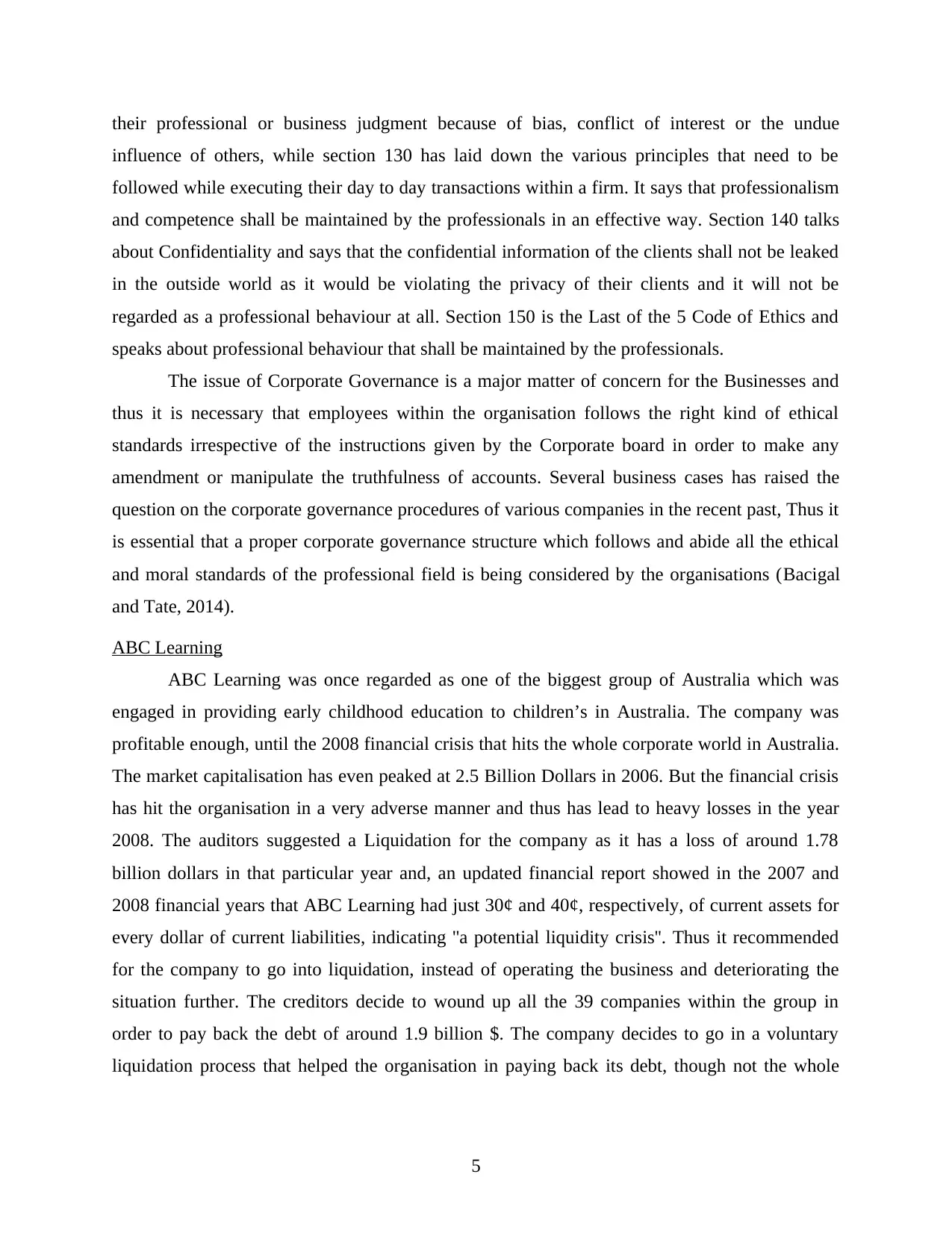
their professional or business judgment because of bias, conflict of interest or the undue
influence of others, while section 130 has laid down the various principles that need to be
followed while executing their day to day transactions within a firm. It says that professionalism
and competence shall be maintained by the professionals in an effective way. Section 140 talks
about Confidentiality and says that the confidential information of the clients shall not be leaked
in the outside world as it would be violating the privacy of their clients and it will not be
regarded as a professional behaviour at all. Section 150 is the Last of the 5 Code of Ethics and
speaks about professional behaviour that shall be maintained by the professionals.
The issue of Corporate Governance is a major matter of concern for the Businesses and
thus it is necessary that employees within the organisation follows the right kind of ethical
standards irrespective of the instructions given by the Corporate board in order to make any
amendment or manipulate the truthfulness of accounts. Several business cases has raised the
question on the corporate governance procedures of various companies in the recent past, Thus it
is essential that a proper corporate governance structure which follows and abide all the ethical
and moral standards of the professional field is being considered by the organisations (Bacigal
and Tate, 2014).
ABC Learning
ABC Learning was once regarded as one of the biggest group of Australia which was
engaged in providing early childhood education to children’s in Australia. The company was
profitable enough, until the 2008 financial crisis that hits the whole corporate world in Australia.
The market capitalisation has even peaked at 2.5 Billion Dollars in 2006. But the financial crisis
has hit the organisation in a very adverse manner and thus has lead to heavy losses in the year
2008. The auditors suggested a Liquidation for the company as it has a loss of around 1.78
billion dollars in that particular year and, an updated financial report showed in the 2007 and
2008 financial years that ABC Learning had just 30¢ and 40¢, respectively, of current assets for
every dollar of current liabilities, indicating ''a potential liquidity crisis''. Thus it recommended
for the company to go into liquidation, instead of operating the business and deteriorating the
situation further. The creditors decide to wound up all the 39 companies within the group in
order to pay back the debt of around 1.9 billion $. The company decides to go in a voluntary
liquidation process that helped the organisation in paying back its debt, though not the whole
5
influence of others, while section 130 has laid down the various principles that need to be
followed while executing their day to day transactions within a firm. It says that professionalism
and competence shall be maintained by the professionals in an effective way. Section 140 talks
about Confidentiality and says that the confidential information of the clients shall not be leaked
in the outside world as it would be violating the privacy of their clients and it will not be
regarded as a professional behaviour at all. Section 150 is the Last of the 5 Code of Ethics and
speaks about professional behaviour that shall be maintained by the professionals.
The issue of Corporate Governance is a major matter of concern for the Businesses and
thus it is necessary that employees within the organisation follows the right kind of ethical
standards irrespective of the instructions given by the Corporate board in order to make any
amendment or manipulate the truthfulness of accounts. Several business cases has raised the
question on the corporate governance procedures of various companies in the recent past, Thus it
is essential that a proper corporate governance structure which follows and abide all the ethical
and moral standards of the professional field is being considered by the organisations (Bacigal
and Tate, 2014).
ABC Learning
ABC Learning was once regarded as one of the biggest group of Australia which was
engaged in providing early childhood education to children’s in Australia. The company was
profitable enough, until the 2008 financial crisis that hits the whole corporate world in Australia.
The market capitalisation has even peaked at 2.5 Billion Dollars in 2006. But the financial crisis
has hit the organisation in a very adverse manner and thus has lead to heavy losses in the year
2008. The auditors suggested a Liquidation for the company as it has a loss of around 1.78
billion dollars in that particular year and, an updated financial report showed in the 2007 and
2008 financial years that ABC Learning had just 30¢ and 40¢, respectively, of current assets for
every dollar of current liabilities, indicating ''a potential liquidity crisis''. Thus it recommended
for the company to go into liquidation, instead of operating the business and deteriorating the
situation further. The creditors decide to wound up all the 39 companies within the group in
order to pay back the debt of around 1.9 billion $. The company decides to go in a voluntary
liquidation process that helped the organisation in paying back its debt, though not the whole
5
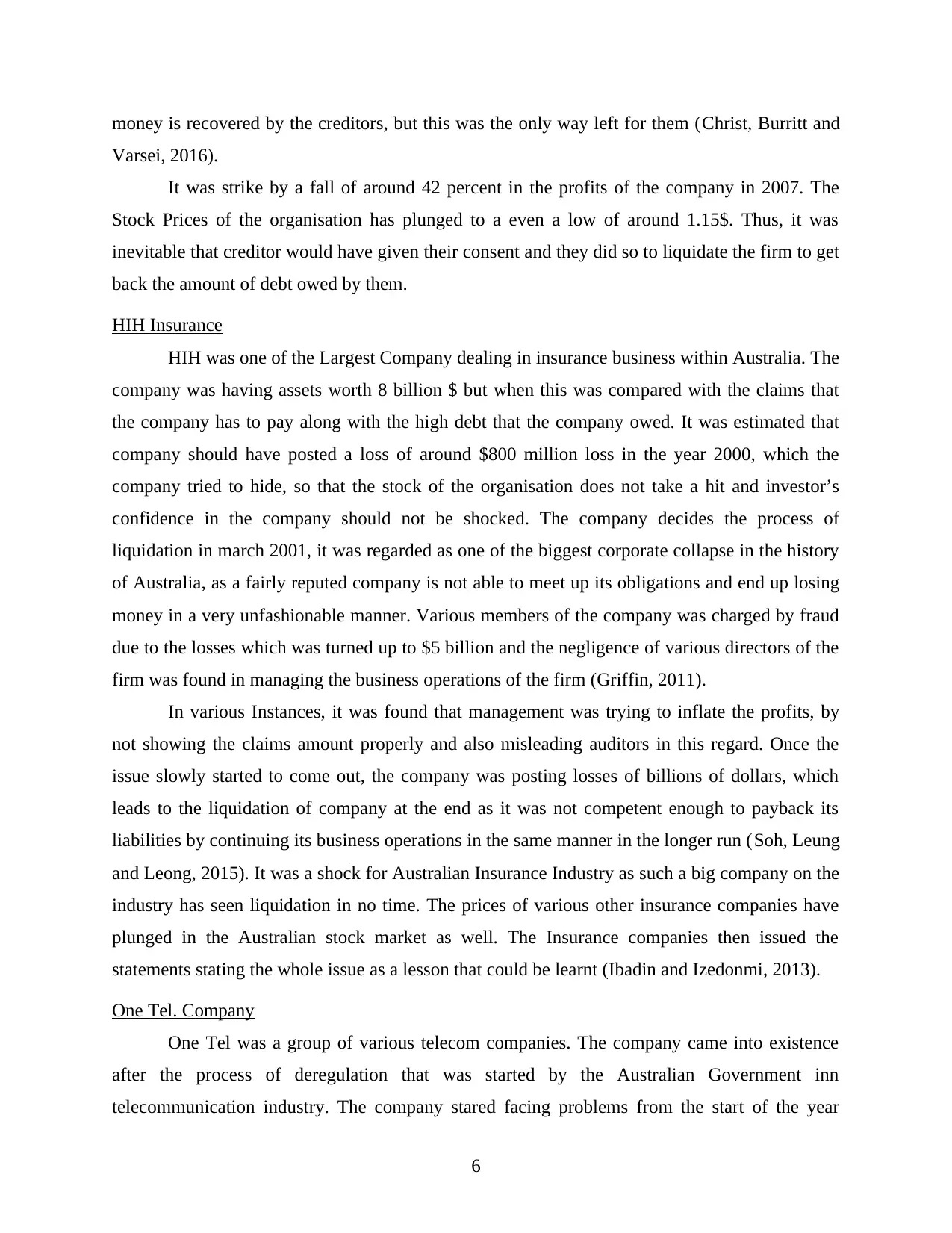
money is recovered by the creditors, but this was the only way left for them (Christ, Burritt and
Varsei, 2016).
It was strike by a fall of around 42 percent in the profits of the company in 2007. The
Stock Prices of the organisation has plunged to a even a low of around 1.15$. Thus, it was
inevitable that creditor would have given their consent and they did so to liquidate the firm to get
back the amount of debt owed by them.
HIH Insurance
HIH was one of the Largest Company dealing in insurance business within Australia. The
company was having assets worth 8 billion $ but when this was compared with the claims that
the company has to pay along with the high debt that the company owed. It was estimated that
company should have posted a loss of around $800 million loss in the year 2000, which the
company tried to hide, so that the stock of the organisation does not take a hit and investor’s
confidence in the company should not be shocked. The company decides the process of
liquidation in march 2001, it was regarded as one of the biggest corporate collapse in the history
of Australia, as a fairly reputed company is not able to meet up its obligations and end up losing
money in a very unfashionable manner. Various members of the company was charged by fraud
due to the losses which was turned up to $5 billion and the negligence of various directors of the
firm was found in managing the business operations of the firm (Griffin, 2011).
In various Instances, it was found that management was trying to inflate the profits, by
not showing the claims amount properly and also misleading auditors in this regard. Once the
issue slowly started to come out, the company was posting losses of billions of dollars, which
leads to the liquidation of company at the end as it was not competent enough to payback its
liabilities by continuing its business operations in the same manner in the longer run (Soh, Leung
and Leong, 2015). It was a shock for Australian Insurance Industry as such a big company on the
industry has seen liquidation in no time. The prices of various other insurance companies have
plunged in the Australian stock market as well. The Insurance companies then issued the
statements stating the whole issue as a lesson that could be learnt (Ibadin and Izedonmi, 2013).
One Tel. Company
One Tel was a group of various telecom companies. The company came into existence
after the process of deregulation that was started by the Australian Government inn
telecommunication industry. The company stared facing problems from the start of the year
6
Varsei, 2016).
It was strike by a fall of around 42 percent in the profits of the company in 2007. The
Stock Prices of the organisation has plunged to a even a low of around 1.15$. Thus, it was
inevitable that creditor would have given their consent and they did so to liquidate the firm to get
back the amount of debt owed by them.
HIH Insurance
HIH was one of the Largest Company dealing in insurance business within Australia. The
company was having assets worth 8 billion $ but when this was compared with the claims that
the company has to pay along with the high debt that the company owed. It was estimated that
company should have posted a loss of around $800 million loss in the year 2000, which the
company tried to hide, so that the stock of the organisation does not take a hit and investor’s
confidence in the company should not be shocked. The company decides the process of
liquidation in march 2001, it was regarded as one of the biggest corporate collapse in the history
of Australia, as a fairly reputed company is not able to meet up its obligations and end up losing
money in a very unfashionable manner. Various members of the company was charged by fraud
due to the losses which was turned up to $5 billion and the negligence of various directors of the
firm was found in managing the business operations of the firm (Griffin, 2011).
In various Instances, it was found that management was trying to inflate the profits, by
not showing the claims amount properly and also misleading auditors in this regard. Once the
issue slowly started to come out, the company was posting losses of billions of dollars, which
leads to the liquidation of company at the end as it was not competent enough to payback its
liabilities by continuing its business operations in the same manner in the longer run (Soh, Leung
and Leong, 2015). It was a shock for Australian Insurance Industry as such a big company on the
industry has seen liquidation in no time. The prices of various other insurance companies have
plunged in the Australian stock market as well. The Insurance companies then issued the
statements stating the whole issue as a lesson that could be learnt (Ibadin and Izedonmi, 2013).
One Tel. Company
One Tel was a group of various telecom companies. The company came into existence
after the process of deregulation that was started by the Australian Government inn
telecommunication industry. The company stared facing problems from the start of the year
6
You're viewing a preview
Unlock full access by subscribing today!
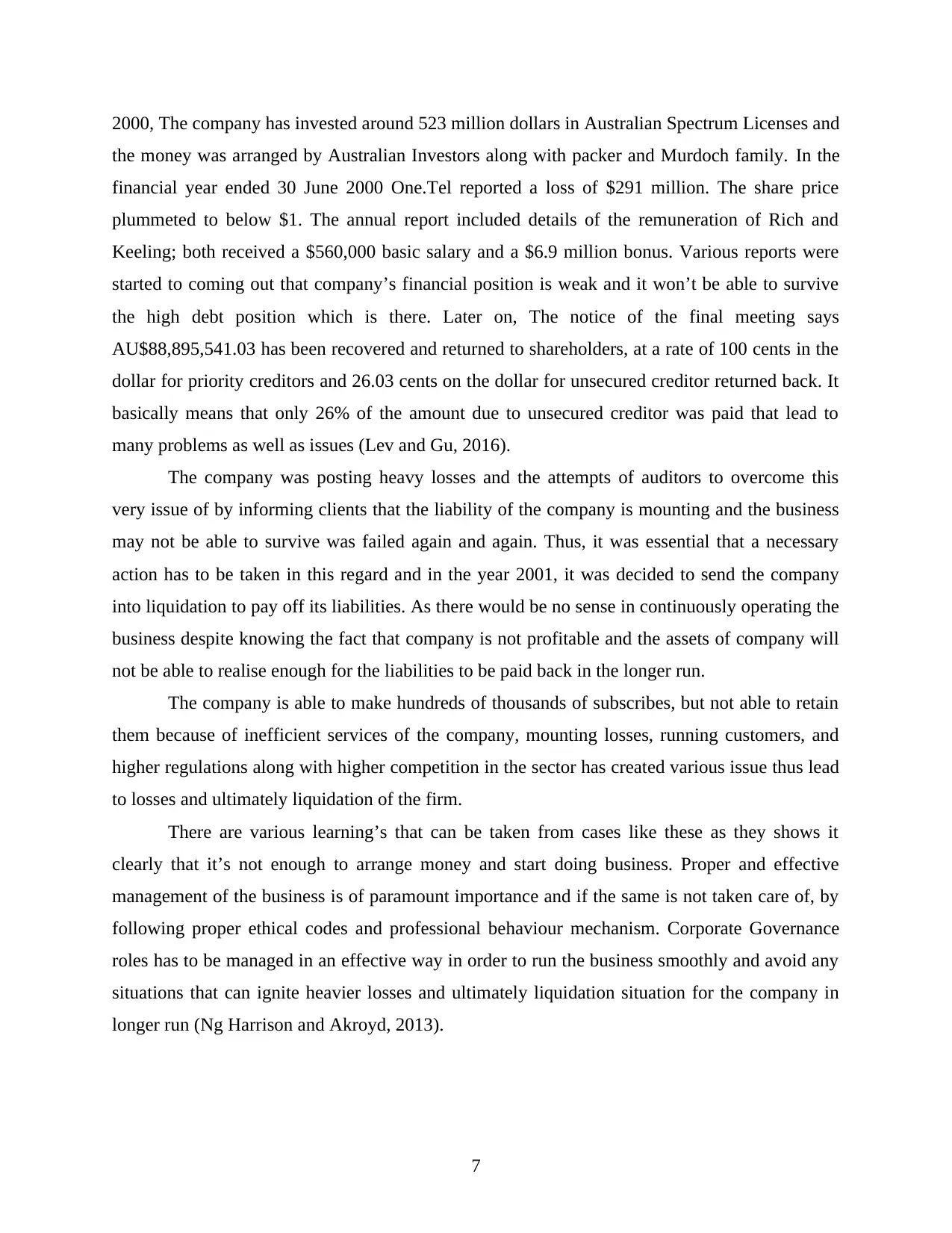
2000, The company has invested around 523 million dollars in Australian Spectrum Licenses and
the money was arranged by Australian Investors along with packer and Murdoch family. In the
financial year ended 30 June 2000 One.Tel reported a loss of $291 million. The share price
plummeted to below $1. The annual report included details of the remuneration of Rich and
Keeling; both received a $560,000 basic salary and a $6.9 million bonus. Various reports were
started to coming out that company’s financial position is weak and it won’t be able to survive
the high debt position which is there. Later on, The notice of the final meeting says
AU$88,895,541.03 has been recovered and returned to shareholders, at a rate of 100 cents in the
dollar for priority creditors and 26.03 cents on the dollar for unsecured creditor returned back. It
basically means that only 26% of the amount due to unsecured creditor was paid that lead to
many problems as well as issues (Lev and Gu, 2016).
The company was posting heavy losses and the attempts of auditors to overcome this
very issue of by informing clients that the liability of the company is mounting and the business
may not be able to survive was failed again and again. Thus, it was essential that a necessary
action has to be taken in this regard and in the year 2001, it was decided to send the company
into liquidation to pay off its liabilities. As there would be no sense in continuously operating the
business despite knowing the fact that company is not profitable and the assets of company will
not be able to realise enough for the liabilities to be paid back in the longer run.
The company is able to make hundreds of thousands of subscribes, but not able to retain
them because of inefficient services of the company, mounting losses, running customers, and
higher regulations along with higher competition in the sector has created various issue thus lead
to losses and ultimately liquidation of the firm.
There are various learning’s that can be taken from cases like these as they shows it
clearly that it’s not enough to arrange money and start doing business. Proper and effective
management of the business is of paramount importance and if the same is not taken care of, by
following proper ethical codes and professional behaviour mechanism. Corporate Governance
roles has to be managed in an effective way in order to run the business smoothly and avoid any
situations that can ignite heavier losses and ultimately liquidation situation for the company in
longer run (Ng Harrison and Akroyd, 2013).
7
the money was arranged by Australian Investors along with packer and Murdoch family. In the
financial year ended 30 June 2000 One.Tel reported a loss of $291 million. The share price
plummeted to below $1. The annual report included details of the remuneration of Rich and
Keeling; both received a $560,000 basic salary and a $6.9 million bonus. Various reports were
started to coming out that company’s financial position is weak and it won’t be able to survive
the high debt position which is there. Later on, The notice of the final meeting says
AU$88,895,541.03 has been recovered and returned to shareholders, at a rate of 100 cents in the
dollar for priority creditors and 26.03 cents on the dollar for unsecured creditor returned back. It
basically means that only 26% of the amount due to unsecured creditor was paid that lead to
many problems as well as issues (Lev and Gu, 2016).
The company was posting heavy losses and the attempts of auditors to overcome this
very issue of by informing clients that the liability of the company is mounting and the business
may not be able to survive was failed again and again. Thus, it was essential that a necessary
action has to be taken in this regard and in the year 2001, it was decided to send the company
into liquidation to pay off its liabilities. As there would be no sense in continuously operating the
business despite knowing the fact that company is not profitable and the assets of company will
not be able to realise enough for the liabilities to be paid back in the longer run.
The company is able to make hundreds of thousands of subscribes, but not able to retain
them because of inefficient services of the company, mounting losses, running customers, and
higher regulations along with higher competition in the sector has created various issue thus lead
to losses and ultimately liquidation of the firm.
There are various learning’s that can be taken from cases like these as they shows it
clearly that it’s not enough to arrange money and start doing business. Proper and effective
management of the business is of paramount importance and if the same is not taken care of, by
following proper ethical codes and professional behaviour mechanism. Corporate Governance
roles has to be managed in an effective way in order to run the business smoothly and avoid any
situations that can ignite heavier losses and ultimately liquidation situation for the company in
longer run (Ng Harrison and Akroyd, 2013).
7
Paraphrase This Document
Need a fresh take? Get an instant paraphrase of this document with our AI Paraphraser
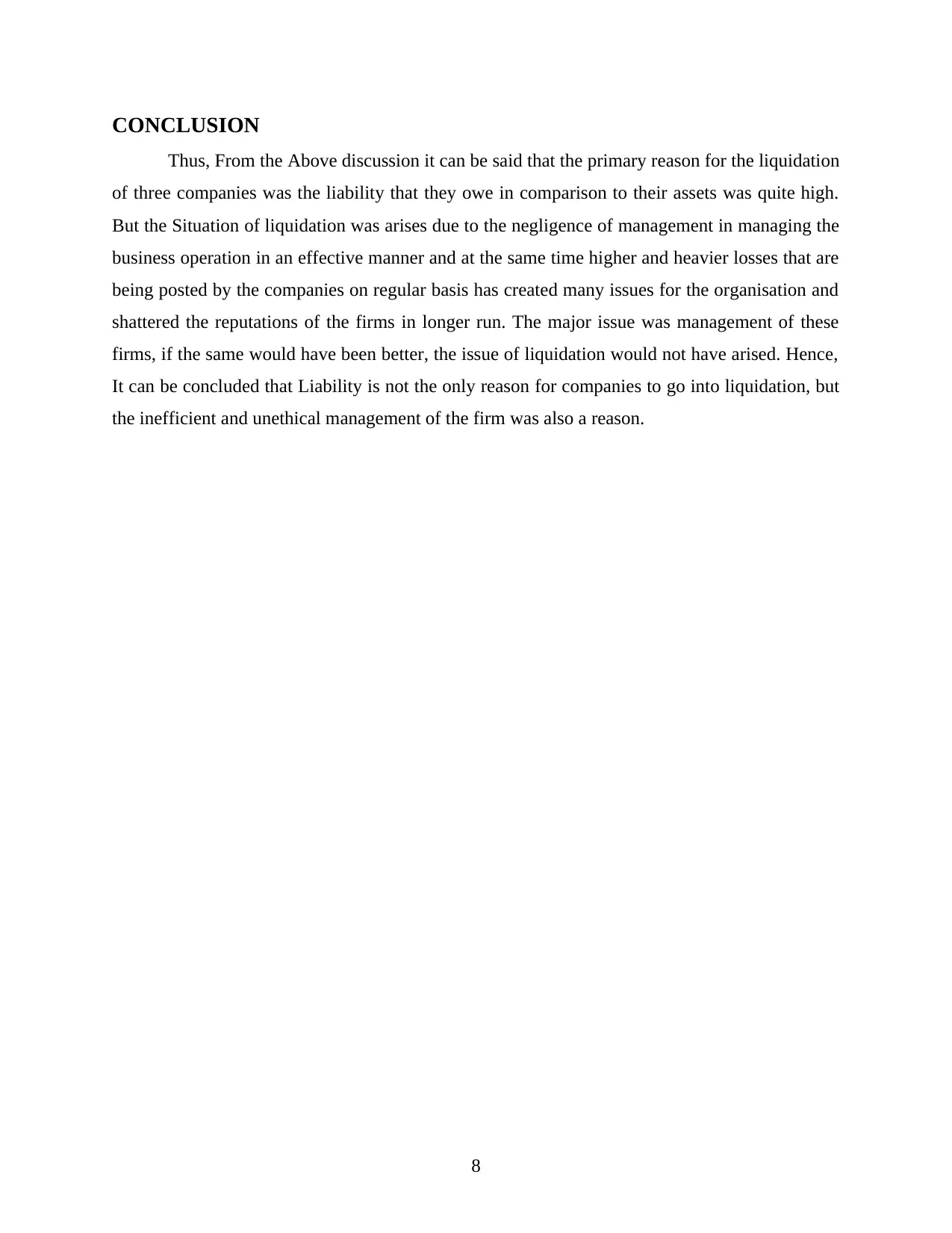
CONCLUSION
Thus, From the Above discussion it can be said that the primary reason for the liquidation
of three companies was the liability that they owe in comparison to their assets was quite high.
But the Situation of liquidation was arises due to the negligence of management in managing the
business operation in an effective manner and at the same time higher and heavier losses that are
being posted by the companies on regular basis has created many issues for the organisation and
shattered the reputations of the firms in longer run. The major issue was management of these
firms, if the same would have been better, the issue of liquidation would not have arised. Hence,
It can be concluded that Liability is not the only reason for companies to go into liquidation, but
the inefficient and unethical management of the firm was also a reason.
8
Thus, From the Above discussion it can be said that the primary reason for the liquidation
of three companies was the liability that they owe in comparison to their assets was quite high.
But the Situation of liquidation was arises due to the negligence of management in managing the
business operation in an effective manner and at the same time higher and heavier losses that are
being posted by the companies on regular basis has created many issues for the organisation and
shattered the reputations of the firms in longer run. The major issue was management of these
firms, if the same would have been better, the issue of liquidation would not have arised. Hence,
It can be concluded that Liability is not the only reason for companies to go into liquidation, but
the inefficient and unethical management of the firm was also a reason.
8
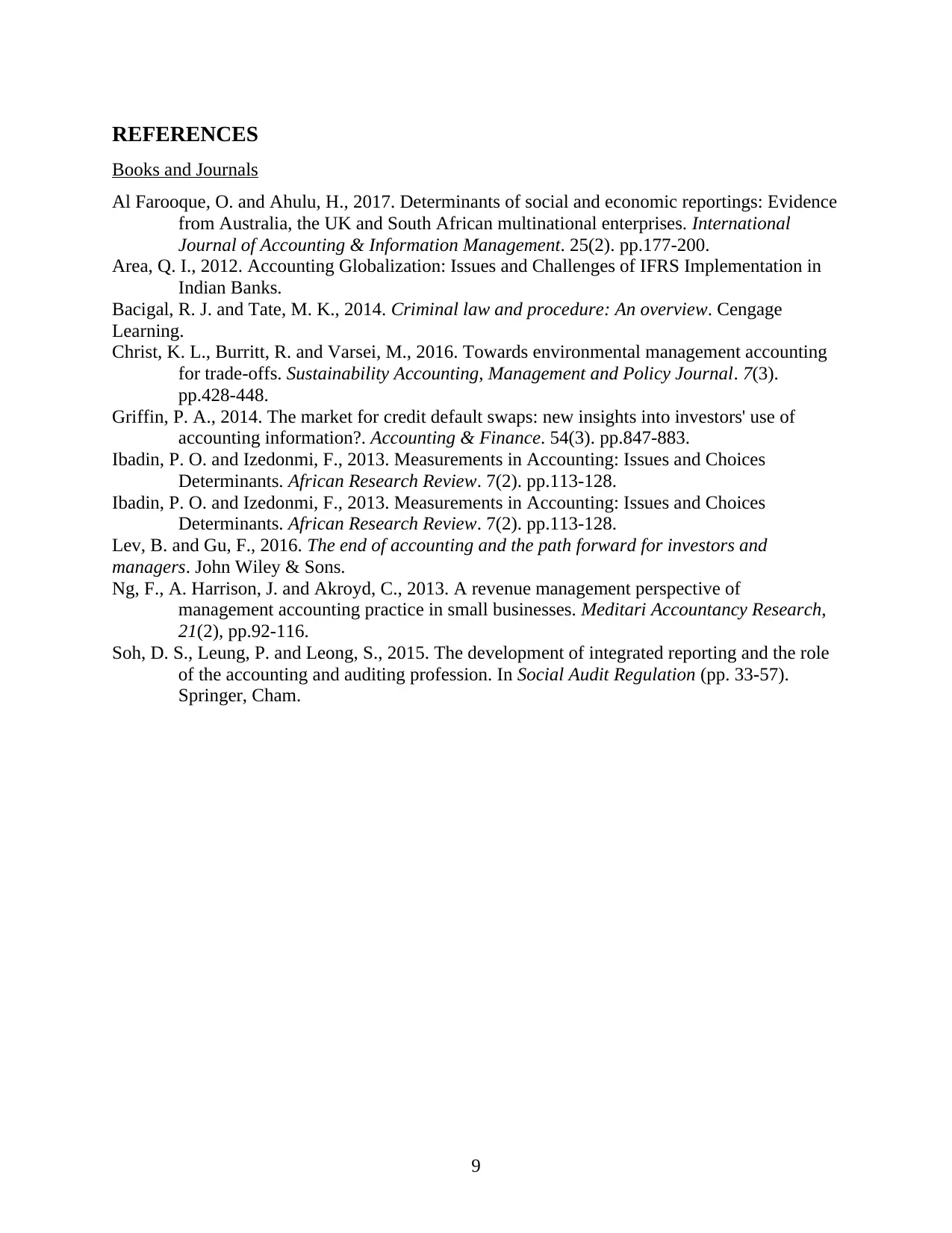
REFERENCES
Books and Journals
Al Farooque, O. and Ahulu, H., 2017. Determinants of social and economic reportings: Evidence
from Australia, the UK and South African multinational enterprises. International
Journal of Accounting & Information Management. 25(2). pp.177-200.
Area, Q. I., 2012. Accounting Globalization: Issues and Challenges of IFRS Implementation in
Indian Banks.
Bacigal, R. J. and Tate, M. K., 2014. Criminal law and procedure: An overview. Cengage
Learning.
Christ, K. L., Burritt, R. and Varsei, M., 2016. Towards environmental management accounting
for trade-offs. Sustainability Accounting, Management and Policy Journal. 7(3).
pp.428-448.
Griffin, P. A., 2014. The market for credit default swaps: new insights into investors' use of
accounting information?. Accounting & Finance. 54(3). pp.847-883.
Ibadin, P. O. and Izedonmi, F., 2013. Measurements in Accounting: Issues and Choices
Determinants. African Research Review. 7(2). pp.113-128.
Ibadin, P. O. and Izedonmi, F., 2013. Measurements in Accounting: Issues and Choices
Determinants. African Research Review. 7(2). pp.113-128.
Lev, B. and Gu, F., 2016. The end of accounting and the path forward for investors and
managers. John Wiley & Sons.
Ng, F., A. Harrison, J. and Akroyd, C., 2013. A revenue management perspective of
management accounting practice in small businesses. Meditari Accountancy Research,
21(2), pp.92-116.
Soh, D. S., Leung, P. and Leong, S., 2015. The development of integrated reporting and the role
of the accounting and auditing profession. In Social Audit Regulation (pp. 33-57).
Springer, Cham.
9
Books and Journals
Al Farooque, O. and Ahulu, H., 2017. Determinants of social and economic reportings: Evidence
from Australia, the UK and South African multinational enterprises. International
Journal of Accounting & Information Management. 25(2). pp.177-200.
Area, Q. I., 2012. Accounting Globalization: Issues and Challenges of IFRS Implementation in
Indian Banks.
Bacigal, R. J. and Tate, M. K., 2014. Criminal law and procedure: An overview. Cengage
Learning.
Christ, K. L., Burritt, R. and Varsei, M., 2016. Towards environmental management accounting
for trade-offs. Sustainability Accounting, Management and Policy Journal. 7(3).
pp.428-448.
Griffin, P. A., 2014. The market for credit default swaps: new insights into investors' use of
accounting information?. Accounting & Finance. 54(3). pp.847-883.
Ibadin, P. O. and Izedonmi, F., 2013. Measurements in Accounting: Issues and Choices
Determinants. African Research Review. 7(2). pp.113-128.
Ibadin, P. O. and Izedonmi, F., 2013. Measurements in Accounting: Issues and Choices
Determinants. African Research Review. 7(2). pp.113-128.
Lev, B. and Gu, F., 2016. The end of accounting and the path forward for investors and
managers. John Wiley & Sons.
Ng, F., A. Harrison, J. and Akroyd, C., 2013. A revenue management perspective of
management accounting practice in small businesses. Meditari Accountancy Research,
21(2), pp.92-116.
Soh, D. S., Leung, P. and Leong, S., 2015. The development of integrated reporting and the role
of the accounting and auditing profession. In Social Audit Regulation (pp. 33-57).
Springer, Cham.
9
You're viewing a preview
Unlock full access by subscribing today!
1 out of 9
Related Documents
Your All-in-One AI-Powered Toolkit for Academic Success.
+13062052269
info@desklib.com
Available 24*7 on WhatsApp / Email
![[object Object]](/_next/static/media/star-bottom.7253800d.svg)
Unlock your academic potential
© 2024 | Zucol Services PVT LTD | All rights reserved.





